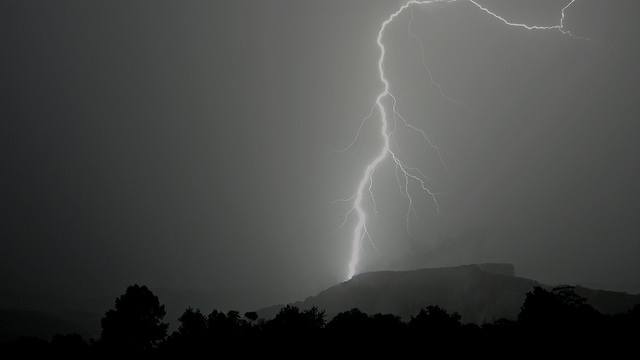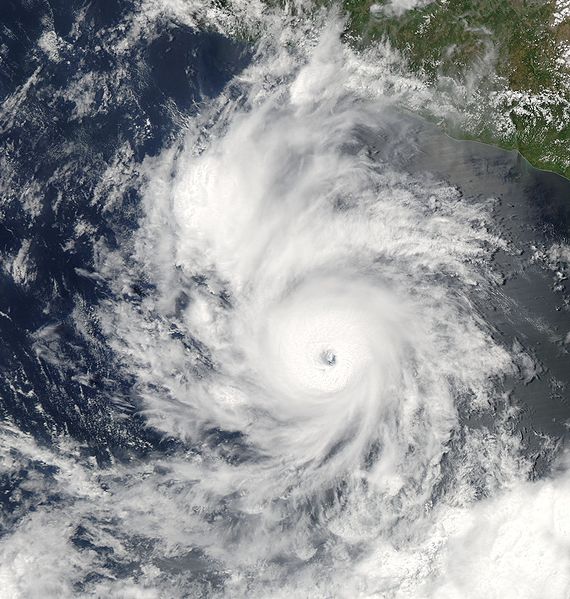
Source: Lightning, Kaptain Kobold, Flickr
Perhaps you remember the children’s book Thunder Cake by Patricia Polacco. A little girl hides under her bed when she hears the frightening “voice of thunder.” Her grandma coaxes her out from her hiding spot by assuring her that this is perfect weather for making a thunder cake. Once the chocolate cake is in the oven, the little girl realizes she has conquered her fear of storms. Polacco’s character suffered from astraphobia, the fear of thunder and lightning.
Given the number of superstorms in recent years, the number of astraphobes might be on the increase.

Source: Holy Monastary of Rousonou,
Dennis Jarvis, Wikipedia
Someone who wants to understand thunder and other aspects of the weather studies meteorology. If you divide the word “meteorology” into two parts, its meaning becomes more transparent. A meteor is something that falls from the sky, a phenomenon that falls from the sky in the Greek language, and the root “–logy” means “study of.” It’s easy to understand that the study of weather, or phenomena that fall from the sky, is meteorology. The Great Meteoron Monastery in Greece, which is built on top of a very high cliff, appears as if it has fallen from the sky like a meteor and landed on top of the cliff.
Click on root, prefix, and suffix to open the three charts you’ll need for the next activity. You may want to print them so you can have them to use later as you continue working to identify new words. Graphic Organizer Instructions

Source: Hurricane Darby, Salamon 650 Wikimedia Commons
Let’s continue to learn about phenomena that falls from the sky by reading about hurricanes and their names. Did you ever wonder why some of the deadliest storms in U.S. history have such friendly sounding names like Andrew, Irene, and Sandy? The following information from the National Weather Service about naming tropical storms and hurricanes will help you understand how this happens.
As you read the text, look inside some of the words that have been highlighted. Your task is to use the chart named in parentheses next to a highlighted word to find the definition of the word part that will help you infer that word’s meaning. For example, look at the word “nameless” in the sentence below, and using your suffix chart, jot down what you think the meaning of “nameless” might be. If you will use these charts as you read challenging text in all of your classes, you will begin to recognize the affixes and add new words to your vocabulary. At the end of this exercise, you will see the highlighted words defined for you.
At one time, tropical storms and hurricanes were nameless (suffix).
On the suffix list, you find that “-less” means “without.” You conclude that storms did not always have first names like Rita and Katrina.
Since 1953, Atlantic tropical storms had been named from lists originated by the National Hurricane Center. They are now maintained and updated through a strict procedure by an 1. international (prefix) committee of the World Meteorological Organization (WMO).
The lists referenced above are used in rotation and 2. recycled (prefix) every six years (i.e., the 2014 list will be used again in 2020). The only time that there is a change in the list is if a storm is so deadly or costly that the future use of its name on a different storm would be 3. inappropriate (prefix) for reasons of sensitivity. If that occurs, then at an annual meeting by the WMO committee (called primarily to discuss many other issues) the offending name is stricken from the list and another name is selected to replace it. Several names have been retired since the lists were created.
If a storm forms in the off-season, it will take the next name in the list based on the current calendar date. For example, if a tropical cyclone formed on December 28th, it would take the name from the 4. previous (prefix) season’s list of names. If a storm formed in February, it would be named from the subsequent season’s list of names.
Reason to Name Hurricanes
Experience shows that the use of short, distinctive names in written as well as spoken communications is 5. quicker (suffix) and less subject to error than the older, more cumbersome latitude-longitude identification methods. These advantages are especially important in exchanging detailed storm information between hundreds of widely scattered stations, coastal bases, and ships at sea.
The use of easily remembered names greatly reduces confusion when two or more tropical storms occur at the same time. For example, one hurricane can be moving slowly westward in the Gulf of Mexico, while at exactly the same time another hurricane can be moving rapidly northward along the Atlantic coast. In the past, confusion and false rumors have arisen when storm advisories broadcast from radio stations were 6. mistaken (prefix) for warnings concerning an entirely different storm located hundreds of miles away.
History of Hurricane Names
For several hundred years many hurricanes in the West Indies were named after the particular saint's day on which the hurricane occurred. In his book, Hurricanes, Ivan R. Tannehill describes the major tropical storms of recorded history and mentions many hurricanes named after saints. For example, there was "Hurricane Santa Ana" which struck Puerto Rico with exceptional violence on July 26, 1825, and "San Felipe" (the first) and "San Felipe" (the second) which hit Puerto Rico on September 13 in both 1876 and 1928.
Tannehill also tells of Clement Wragge, an Australian 7. meteorologist (suffix) who began giving women's names to tropical storms before the end of the 19th century.
An early example of the use of a woman's name for a storm was in George R. Stewart’s novel, Storm, published by Random House in 1941 and since filmed by Walt Disney. During World War II this practice became widespread in weather map discussions among 8. forecasters, (prefix) especially Army and Navy meteorologists who plotted the movements of storms over the wide expanses of the Pacific Ocean.
In 1953, the United States abandoned a confusing two-year-old plan to name storms by a 9. phonetic (Greek root) alphabet (Able, Baker, Charlie) when a new, international phonetic alphabet was introduced. That year, the United States began using female names for storms.
The practice of naming hurricanes solely after women came to an end in 1978 when men's and women's names were 10. included (prefix) in the Eastern North Pacific storm lists. In 1979, male and female names were included in lists for the Atlantic and Gulf of Mexico.
- international (prefix) between or among; between or among nations
- recycled (prefix) again; cycled again
- inappropriate (prefix) not; not appropriate
- previous (prefix) before; occurring before
- quicker (suffix) more; more quick
- mistaken (prefix) wrongly; wrongly taken
- meteorologist (suffix) one who studies; one who studies things in the air
- forecasters (prefix) before; in front of; those who predict events before they happen
- phonetic (Greek root) sound; made up of sounds and their written symbols
- included (prefix) in; contained